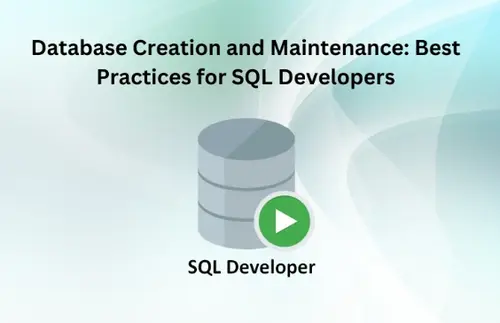SQL Developers have a vital role in data management since they design, build, and administer databases. While SQL Developers know How to Create Database in SQL, maintaining databases effectively is essential to achieving peak performance, security, and dependability.
SQL developers must stay up to date with the newest technology and approaches as the data landscape continues to change. This is where organised learning of the new aspects of database administration, provided by SQL training, is invaluable. This blog focuses on the craft of database creation and maintenance by emphasizing the importance of SQL Training.

Table of Contents
How to Create a Database in SQL
Let’s start with the fundamentals and learn how to construct a database in SQL before getting into the nuances of database management. Relational database management and manipulation are accomplished with the use of a specialized language called SQL, or Structured Query Language.
To create a database in SQL, follow these general steps:
- Access SQL Server Management Studio (SSMS): Open SSMS, the integrated environment for managing SQL Server databases.
- Connect to a Server: Connect to the SQL Server instance where you want to create the database.
- Execute SQL Command: Use the CREATE DATABASE statement to define the database name, file locations, and other attributes.
- Verify Database Creation: Once the command is executed, verify the database creation by refreshing the database’s folder in SSMS.
Database Maintenance Best Practices
Creating a database is just the first step; continuing to manage it is what keeps the data integrity and performance at their best. In the area of database management, SQL developers should adhere to the following best practices:
Regular Backups
To guard against data loss, put in place a strong backup plan. To guarantee dependability, regularly back up databases and evaluate the restoration procedure.
Indexing Strategies
To improve query performance, carefully create and manage indexes. Review and update indexes frequently in response to shifting usage trends.
Performance Monitoring
To keep an eye on database performance, use monitoring tools. To guarantee smooth operations, locate performance bottlenecks and quickly resolve them.
Security Measures
To safeguard sensitive data, put best practices in place. Review and update user permissions regularly and carry out security audits to find weaknesses.
Database Optimisation
Rebuilding indexes, updating statistics, and defragmenting tables are all part of a periodic database optimisation process. By doing this, performance loss is avoided, and efficiency is maintained.
Documentation
Keep thorough records of all table relationships, stored procedures, and triggers related to the database schema. For future development and troubleshooting, documentation is essential.
Automated Maintenance Plans
Simplify regular tasks like backups, integrity checks, and index maintenance by utilising the automated maintenance plans that SQL Server offers. Automation guarantees uniformity and lowers the possibility of human error.
SQL Training for Database Creation
Comprehensive training is necessary to grasp the subtleties of building databases in SQL. The goal of SQL training programmes is to give developers the skills they need to efficiently manage database structures, execute SQL commands, and traverse the complicated features of SQL Server Management Studio.
Developers who take SQL training not only learn the syntax and semantics of SQL but also acquire useful knowledge about creating databases that follow best practices. These courses frequently include data integrity, indexing, and normalization—all crucial components of building reliable and effective databases.
Conclusion
SQL developers need to arm themselves with the knowledge and abilities necessary to not only design databases but also administer them successfully in the ever-changing field of database management. While knowing how to construct a database in SQL is a fundamental step, maintaining optimal performance and data integrity also requires regular maintenance procedures.
SQL training programmes are essential in transforming developers into skilled database administrators by equipping them with the knowledge and skills necessary to successfully negotiate the intricacies of SQL and succeed in their positions.
SQL developers improve the stability and dependability of the systems they oversee by following best practices for database maintenance, which improves the efficiency of the company’s data infrastructure.
